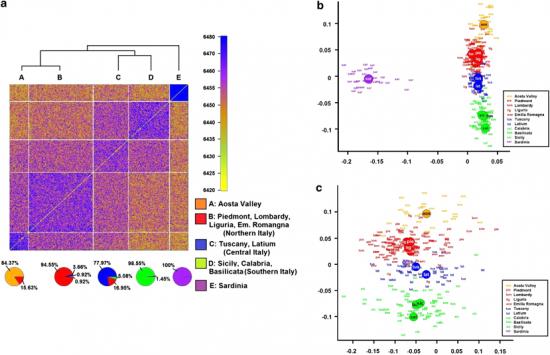Source - http://dienekes.blogspot.fr/
 From the paper:
From the paper:
The distribution of the pairwise Fst distances between all population pairs is shown in Supplementary Table S3. The genetic distance between Southern and Northern Italians (Fst=0.0013) is comparable to that between individuals living in different political units (ie, Iberians-Romanians Fst=0.0011; British-French Fst=0.0007), and, interestingly, in >50% of all the possible pairwise comparisons within Europe (Supplementary Figure S7).
European Journal of Human Genetics advance online publication 11 November 2015; doi: 10.1038/ejhg.2015.233
The Italian genome reflects the history of Europe and the Mediterranean basin
Giovanni Fiorito et al.
Recent scientific literature has highlighted the relevance of population genetic studies both for disease association mapping in admixed populations and for understanding the history of human migrations. Deeper insight into the history of the Italian population is critical for understanding the peopling of Europe. Because of its crucial position at the centre of the Mediterranean basin, the Italian peninsula has experienced a complex history of colonization and migration whose genetic signatures are still present in contemporary Italians. In this study, we investigated genomic variation in the Italian population using 2.5 million single-nucleotide polymorphisms in a sample of more than 300 unrelated Italian subjects with well-defined geographical origins. We combined several analytical approaches to interpret genome-wide data on 1272 individuals from European, Middle Eastern, and North African populations. We detected three major ancestral components contributing different proportions across the Italian peninsula, and signatures of continuous gene flow within Italy, which have produced remarkable genetic variability among contemporary Italians. In addition, we have extracted novel details about the Italian population’s ancestry, identifying the genetic signatures of major historical events in Europe and the Mediterranean basin from the Neolithic (e.g., peopling of Sardinia) to recent times (e.g., ‘barbarian invasion’ of Northern and Central Italy). These results are valuable for further genetic, epidemiological and forensic studies in Italy and in Europe.